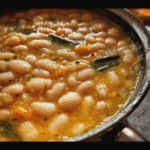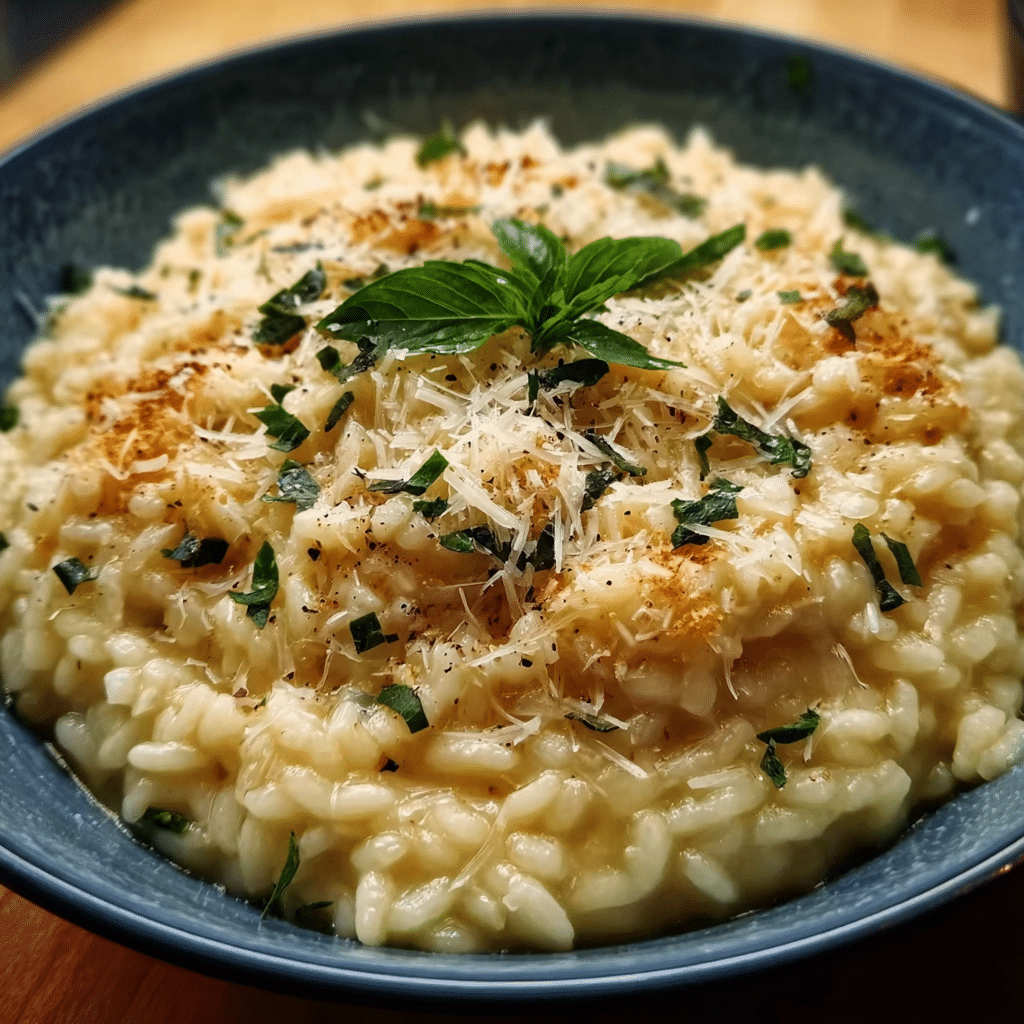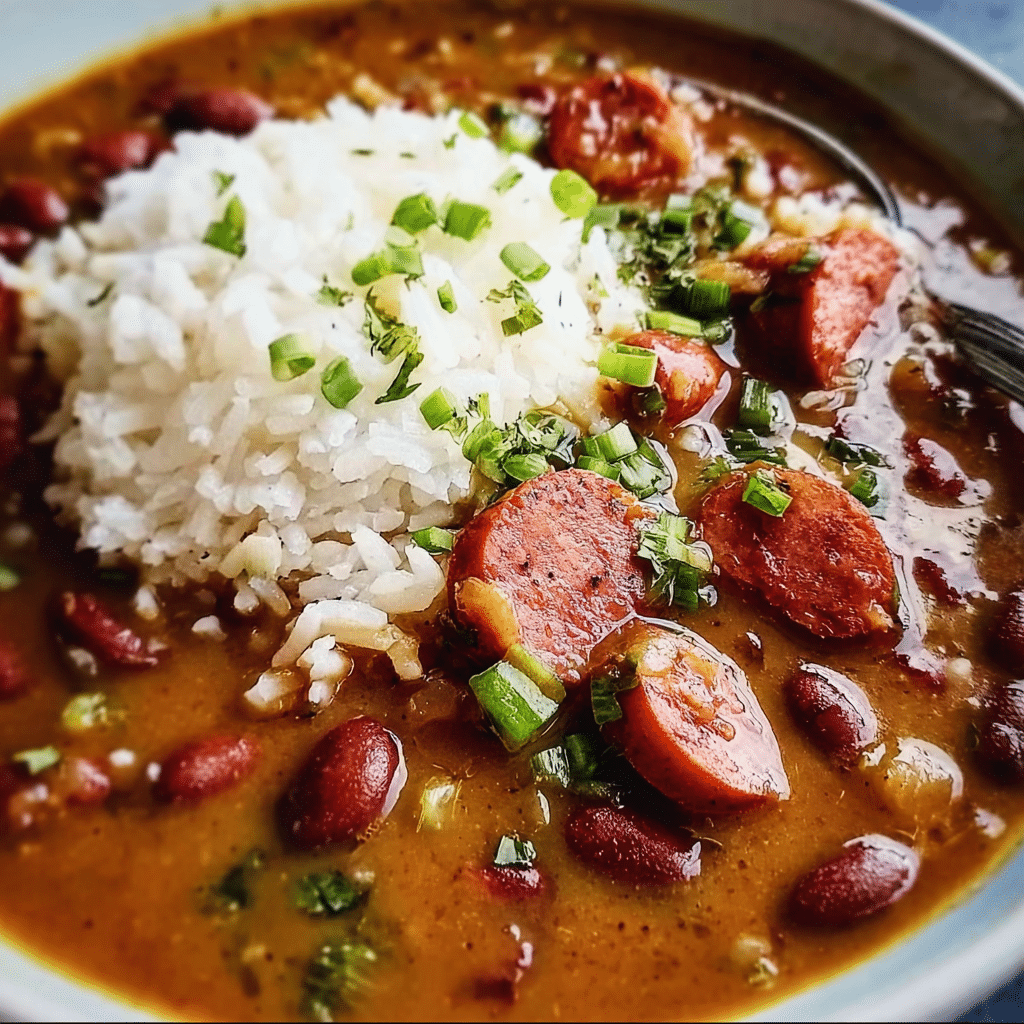Best white bean soup is not just a recipe; it’s a warm embrace on a cold day, a tantalizing blend of flavors that can transport you to another place and time. My journey with this dish began on a chilly autumn evening. I remember standing in my kitchen, the smell of garlic and onions wafting through the air as I sautéed them in a pot. It was one of those moments when the world outside was draped in a blanket of fallen leaves, and the sky was a canvas of deep orange and purple hues. I had just returned from a weekend trip to a quaint little town that boasted a charming farmers’ market, where I picked up fresh herbs and some of the most beautiful white beans I had ever seen. I couldn’t wait to transform these ingredients into what I would soon discover to be the best white bean soup I ever tasted.

As I stirred the pot, I felt an overwhelming sense of connection to the generations of cooks who had prepared similar dishes before me. The rich history of white bean soup spans numerous cultures, from the rustic kitchens of Italy to the hearty fare of New England. Each region adds its own unique twist, yet the essence remains the same: a comforting, nourishing meal that brings people together. It’s fascinating to think how a simple combination of beans, vegetables, and broth can carry so much history and cultural significance. The tradition of making soup in my family was passed down from my grandmother, who always said that a good soup can heal a broken heart or warm the coldest of days.
The Story Behind This Recipe
What makes this particular recipe for the best white bean soup so special is its adaptability. You can easily swap in any seasonal vegetables you have on hand or add your favorite spices. For instance, on that memorable evening, I added kale and a pinch of smoked paprika, which elevated the flavors and created a rich depth that made my taste buds dance. It’s that flexibility that makes this soup perfect for busy families looking for quick dinner solutions. You can prepare it in under an hour, with minimal effort, and serve it with crusty bread for a complete meal.
Seasonal relevance is another reason why I cherish this recipe. While it’s a fantastic dish for chilly nights in the fall and winter, I’ve found that a lighter version with fresh herbs and lemon zest can be just as delightful in the spring. The best white bean soup can be a year-round staple, evolving with the seasons and whatever fresh produce is available. It’s a reminder of nature’s bounty and the joy of cooking with what’s at hand.
Every time I prepare this soup, I feel a profound emotional connection to my past and to the act of cooking itself. It evokes memories of gathering around the table with family, the laughter and chatter, and the love that fills the air. This soup is more than just a recipe; it’s a way to share stories and create new memories. It’s an invitation to slow down, to enjoy each bite, and to appreciate the simple yet profound act of nourishing ourselves and others.
In this article, I promise to guide you through everything you need to know to make the best white bean soup. From the ingredients that make it flavorful and nutritious to tips on how to customize it for your family’s taste, you’ll discover how easy it is to create this heartwarming dish at home. So grab your apron, and let’s dive into a world of flavors that will keep you and your loved ones coming back for more!
The Rich History and Cultural Significance of best white bean
The story of the best white bean soup is deeply rooted in history, culture, and the changing seasons. To truly appreciate this dish, it’s important to delve into its origins and understand how it has evolved over time. The humble white bean, also known as cannellini or navy bean, has been a staple in many diets for centuries. These beans are packed with protein, fiber, and essential nutrients, making them a popular choice among various cultures that prioritize hearty, nourishing meals.
Origins and History
White beans are believed to have originated in the Americas, where they were cultivated by indigenous peoples long before European settlers arrived. The earliest records of bean cultivation date back to around 5000 BC. However, it was in Europe, particularly in Italy, where the white bean soup truly flourished. Italian cooks have long celebrated beans as a source of sustenance, integrating them into numerous dishes, with white bean soup being one of the most beloved. This dish often features prominently in Tuscan cuisine, where it is commonly made with fresh herbs and olive oil, reflecting the region’s emphasis on using high-quality, local ingredients.
In the United States, particularly in New England, white bean soup became a quintessential comfort food, often associated with the cold winters and hearty meals shared among families. The dish evolved into variations that included ingredients like ham, vegetables, and even tomatoes, each adding a unique twist while maintaining the soul of the recipe. The adaptability of white bean soup makes it a canvas for creativity, allowing each cook to leave their personal mark.
Cultural Significance
This soup holds a special place in various cultural traditions. In Italy, it may be served during harvest festivals, celebrating the bounty of the land. In New England, it often graces tables during family gatherings and holiday celebrations. It is not uncommon for this dish to be served at potlucks or community events, where it symbolizes sharing and togetherness. The warmth of the soup is a reflection of the warmth of the community, making it more than just a meal; it’s a tradition that binds people together.
Some famous chefs have put their own spin on the best white bean soup, elevating it to fine dining status. Restaurants across the country have featured their unique versions, showcasing regional ingredients and innovative techniques. This evolution in preparation reflects the ongoing love affair with the soup, proving that while recipes may change, the essence of comfort remains.
Nutritional Benefits
In addition to its cultural significance, the nutritional benefits of the best white bean soup are noteworthy. White beans are an excellent source of protein, making them a fantastic meat alternative for vegetarians and vegans. They are also rich in dietary fiber, which aids digestion and helps maintain a healthy weight. Additionally, these beans are packed with essential vitamins and minerals, including iron, magnesium, and folate. When combined with fresh vegetables and herbs, the soup becomes a powerhouse of nutrition, promoting overall health and well-being.
As we explore the rich history and cultural significance of the best white bean soup, it’s clear that this dish is so much more than a simple meal. It embodies tradition, warmth, and the joy of sharing food with loved ones. Whether it’s a family recipe passed down through generations or a new twist on an old classic, this soup continues to be a favorite in kitchens around the world.
Essential Ingredients for Perfect best white bean
When it comes to crafting the best white bean soup, the ingredients play a pivotal role in shaping the dish’s flavor, texture, and overall appeal. Each component adds its unique character, and understanding their importance can elevate your soup from good to unforgettable. Let’s explore the essential ingredients required to create the best white bean soup, along with some tips on selection, storage, and substitutions.
Essential Ingredients
- 2 cans (28oz, 800 grams) cannellini beans or white beans, drained
- 1 medium-sized onion, diced
- 1 celery stalk, diced
- 1 large carrot, diced
- 1-2 garlic cloves, diced or pressed
- 1 cup (7 oz, 200 grams) frozen spinach (optional)
- 2 medium-sized potatoes, peeled and cut into chunks
- 1 tablespoon olive oil, plus more for serving
- 1 tablespoon tomato paste
- 1/3 cup (80 ml) white wine
- 1 sprig rosemary or 1 tablespoon of chopped fresh leaves or 1/2 teaspoon of dried
- 2 cups (500 ml) vegetable broth or hot water
- 1/2 teaspoon paprika (optional)
- 1/2 teaspoon fine salt, plus more to taste
- 1/8 teaspoon black pepper, plus more to taste
Now, let’s delve into the significance of each ingredient:
- Cannellini Beans: These creamy, tender beans are the star of the show, providing a hearty base and protein content. They have a slightly nutty flavor that complements the other ingredients. When selecting canned beans, look for brands that use minimal preservatives and have a good texture—avoid overly mushy beans.
- Onion: A foundational flavor in the best white bean soup, onions add sweetness and depth when sautéed. Opt for yellow onions for a balanced flavor that won’t overpower the dish.
- Celery: This aromatic vegetable adds a lovely crunch and a fresh note. Choose firm, bright green celery stalks for the best flavor.
- Carrot: Diced carrots introduce a natural sweetness and vibrant color. Fresh, crisp carrots are ideal, as they retain their texture in the soup.
- Garlic: Fresh garlic elevates the soup with its pungent aroma and flavor. Pressing or finely chopping allows the oils to release, enhancing the overall taste. Select firm cloves for the best potency.
- Frozen Spinach: While optional, spinach adds a nutritional boost and a pop of color. If using frozen, ensure there are no added sauces or seasonings. Fresh spinach can be substituted if sautéed beforehand.
- Potatoes: These starchy vegetables help thicken the soup and provide a comforting texture. Russet or Yukon Gold varieties work well; just make sure they are peeled and cut into uniform chunks for even cooking.
- Olive Oil: A drizzle of good quality extra virgin olive oil not only adds richness but also enhances the flavors of the other ingredients. Look for oil with a fruity aroma and a robust taste.
- Tomato Paste: This ingredient gives the soup a subtle umami flavor and enhances the overall color. Choose a high-quality paste with a deep red color for the best impact.
- White Wine: Adding a bit of white wine brightens the flavor profile and adds complexity. A dry wine is preferable; avoid sweet varieties. If you’re avoiding alcohol, consider using additional broth or a splash of vinegar instead.
- Rosemary: Fresh rosemary brings an aromatic earthiness that pairs beautifully with beans. If using dried, be sure to adjust the amount as it’s more potent.
- Vegetable Broth: This is the liquid base that brings everything together. Homemade broth is always best if you have the time, but store-bought works well too. Ensure it’s low-sodium to control the saltiness of your dish.
- Paprika: This optional spice adds warmth and a hint of smokiness. Use smoked paprika for an extra layer of flavor.
- Salt and Pepper: Essential for seasoning, these ingredients bring out the natural flavors of your soup. Always taste and adjust accordingly as you cook.

Best White Bean Soup
Ingredients
- 2 cans (28oz – 800 grams) cannellini beans or white beans, drained
- 1 medium-size onion, diced
- 1 celery stalk, diced
- 1 large carrot, diced
- 1–2 garlic cloves, diced or pressed
- 1 cup (7 oz – 200 grams), frozen spinach * (optional)
- 2 medium-size potatoes, peeled and cut into chunks
- 1 Tbsp olive oil, plus more for serving
- 1 Tbsp tomato paste
- 1/3 cup (80 ml) white wine
- 1 sprig rosemary (or 1 Tbsp of chopped fresh leaves/1/2 tsp of dried)
- 2 cups (500 ml) vegetable broth or hot water
- 1/2 tsp paprika (optional)
- 1/2 tsp fine salt, plus more to taste
- 1/8 tsp black pepper, plus more to taste
Instructions
-
-
Warm the olive oil in a large pot over medium heat. Once the oil is shimmering, add the diced onion, carrot, and celery. Cook, stirring often, until the onion has softened and is turning translucent, about 5 minutes.
-
-
Add the garlic, beans, tomato paste, potatoes, rosemary (whole sprig, chopped, or dried, whatever it’s easier for you) and paprika (if you use it). Cook stirring frequently, about 1 minute.
-
Add the wine, stir well and let it simmer until it has evaporated, cooking for another minute.
-
Then add the frozen spinach, the vegetable broth and a good pinch of salt and pepper. Raise the heat and bring the mixture to a boil, then cover the pot, reduce heat and cook gently for 15 minutes.
-
When the potatoes are soft and the soup is thick and creamy, remove the pot from heat, then remove the sprig rosemary*. Taste and season with salt and pepper. (I usually add a pinch of salt at the beginning + 1/2 tsp later. You might need more salt, depending on your vegetable broth and on your personal preferences.)*
-
Divide into bowls, drizzle with olive oil or extra virgin olive oil, and more freshly ground black pepper if you like. Serve with crusty whole grain bread and, if you don’t keep it vegan, add freshly grated parmesan cheese for extra flavor. Enjoy!
Shopping Tips
When shopping for the ingredients for the best white bean soup, consider sourcing from local farmers’ markets for fresh produce. This not only supports local agriculture but also ensures that you’re getting the freshest ingredients available. If you’re opting for canned beans, check the labels for low-sodium options to keep the soup healthier.
Substitutions and Alternatives
If you have dietary restrictions or preferences, several substitutions can be made without compromising the essence of the soup. For instance, you can use vegetable broth instead of chicken broth for a vegan version or swap the white wine for additional broth or a splash of lemon juice for acidity. If you’re avoiding potatoes, you can use cauliflower for a lower-carb option. Be creative, and don’t hesitate to experiment with what you have on hand!
Storing ingredients wisely can also save both time and money. Vegetables like carrots and celery can last for weeks if stored in a cool, dark place, while canned beans can be kept in your pantry for an extended period. Fresh herbs like rosemary can be kept in a glass of water in the fridge to prolong their freshness.
In conclusion, gathering the right ingredients is essential to creating the best white bean soup, and understanding their roles can help you appreciate the cooking process even more. Not only do these ingredients work together to produce a comforting and flavorful dish, but they also tell a story of culinary tradition and the joy of home cooking.
Detailed Step-by-Step best white bean Cooking Instructions
Now that we’ve gathered all the essential ingredients for the best white bean soup, it’s time to dive into the cooking process! This section will guide you through each step, ensuring that you not only achieve a delicious result but also gain confidence in your cooking skills. Let’s embark on this culinary adventure together!
Preparation Steps
- Mise en Place: Before you start cooking, gather all your ingredients and tools. This includes a cutting board, sharp knife, large pot or Dutch oven, measuring cups, and spoons. Having everything organized will streamline your cooking process.
- Dice Your Vegetables: Begin by dicing the onion, celery, and carrot. Aim for uniform sizes to ensure even cooking. When chopping onions, a sharp knife is key—this will minimize tears and make the process quicker.
- Prep the Garlic: Depending on your preference, you can either finely dice or press the garlic cloves. For a stronger garlic flavor, press them. If you prefer a milder taste, finely chopping will suffice.
- Cut the Potatoes: Peel the potatoes and cut them into chunks. Make sure they are roughly the same size for uniform cooking. You want them to be bite-sized, so they blend well into the soup.
- Measure Out the Liquid: In a separate measuring cup, combine the vegetable broth and white wine. This step ensures you have the correct proportions ready to go when it’s time to add them to the pot.
Cooking Process
- Heat the Oil: In your large pot or Dutch oven, heat the olive oil over medium heat. You’ll know it’s ready when it shimmers slightly. This is a crucial step, as the oil needs to be hot enough to sauté your vegetables effectively.
- Sauté the Aromatics: Add the diced onion, celery, and carrot to the pot. Stir frequently, cooking until the vegetables are softened and the onion is translucent, about 5-7 minutes. This step builds the foundational flavor of your soup.
- Add the Garlic: Once the vegetables are softened, add the garlic and sauté for an additional minute until fragrant. Be careful not to let it burn, as burnt garlic can impart a bitter flavor to your soup.
- Incorporate Tomato Paste: Stir in the tomato paste, allowing it to cook for about 2 minutes. This will deepen the flavor of the soup and add a beautiful rich color.
- Add the Potatoes: Toss in the chopped potatoes and stir to combine. This ensures they are coated with the flavorful oil and aromatics.
- Pour in the Liquid: Slowly add the vegetable broth and white wine to the pot, scraping up any bits that may have stuck to the bottom. This adds even more flavor to your soup. Bring the mixture to a gentle boil.
- Add the Beans: Once boiling, reduce the heat to a simmer and add the drained cannellini beans. Stir to combine and let the soup cook for about 15-20 minutes, or until the potatoes are tender. The beans should be heated through but not overly mushy.
- Add Spinach and Season: If you’re using frozen spinach, add it in the last 5 minutes of cooking. Season with salt, pepper, and paprika to taste. Remember, you can always adjust the seasoning later, so start with a little and add more as needed.
Final Assembly
- Texture Check: Once the potatoes are tender, give the soup a taste. This is your moment to adjust any seasonings. If you want it creamier, consider using an immersion blender to puree a portion of the soup, stirring it back in for a thicker consistency.
- Garnish and Serve: Ladle the soup into bowls. Drizzle a little extra olive oil on top for a luxurious finish. You can also sprinkle fresh herbs or a pinch of paprika for a pop of color.
- Storage Tips: If you have leftovers, allow the soup to cool completely before transferring it to airtight containers. It will keep well in the refrigerator for up to 5 days, and you can freeze it for up to 3 months. Just be mindful that the texture of the potatoes may change slightly upon thawing.
- Common Mistakes: One of the biggest mistakes is overcooking the beans. They should be warmed through but not falling apart. Also, be cautious with salt; adding it gradually will prevent your soup from becoming too salty.
In conclusion, following these detailed instructions will guide you to create the best white bean soup that is not only delicious but also comforting and nutritious. From the careful preparation of your ingredients to the final touches before serving, each step is designed to ensure your soup is a success. Enjoy the process and the delightful aromas that will fill your kitchen as you cook!
Professional Tips and Techniques for best white bean
When it comes to crafting the best white bean soup, there are myriad techniques and tricks that can elevate this dish from ordinary to extraordinary. As a passionate home cook, I’ve spent years experimenting with different methods, ingredients, and presentations, and I’m excited to share my insights to help you achieve the best white bean soup ever!

Professional Techniques
To create the best white bean soup, starting with high-quality ingredients is crucial. Fresh herbs, aromatic vegetables, and, of course, the beans themselves should be the stars of your dish. I recommend using dried white beans, such as cannellini or great northern beans, instead of canned. Soaking these beans overnight not only enhances their flavor but also ensures they cook evenly.
When preparing the beans, rinse them thoroughly and soak them in water for at least eight hours or overnight. This process softens the beans and helps them absorb flavors during cooking. If you’re short on time, a quick soak method can work in a pinch: bring the beans to a boil with a generous amount of water, then remove from heat, cover, and let sit for an hour. Regardless of the method, always drain and rinse the beans before cooking.
Another professional technique is the layering of flavors. Start your soup by sautéing aromatics like onions, garlic, and carrots in olive oil over medium heat. This step builds a flavor base that will permeate the entire dish. I often add a pinch of salt early in this process to help draw out moisture from the vegetables, intensifying their flavors.
After the aromatics have softened, it’s time to introduce your soaked beans along with vegetable or chicken broth. A common mistake is to add too much liquid; remember that beans will absorb some of the broth as they cook. A good rule of thumb is to cover the beans by about an inch with liquid. You can always add more liquid later if needed.
Troubleshooting Guide
Even the most seasoned cooks can run into trouble when making soup. A few common issues include beans that are still hard after hours of cooking or a soup that tastes bland. If your beans are not softening, it may be due to old beans that have lost their integrity. Always check the packaging date when purchasing dried beans.
For a bland soup, consider the seasoning. Salt should be added in layers throughout the cooking process, not just at the end. Don’t be afraid to taste and adjust as you go! Fresh herbs can also brighten up the flavor profile, so adding a handful of parsley or thyme towards the end of cooking can make a world of difference.
Presentation Tips
Now that you’ve mastered the cooking process, let’s talk about presentation—the finishing touch! A bowl of the best white bean soup can be elevated with simple garnishes. A drizzle of high-quality olive oil adds a beautiful sheen and an extra layer of flavor. Fresh herbs, such as chopped parsley or a sprinkle of chives, can provide a pop of color and freshness.
When plating, consider the bowl you’re using. A rustic, wide bowl can create a cozy feel, while a sleek, modern bowl can give your soup a contemporary touch. Pair your soup with a crusty baguette or homemade croutons for added texture, and don’t forget a glass of crisp white wine to complement the flavors. A Sauvignon Blanc or a light Pinot Grigio works wonders with white bean soup.
Lastly, for meal prep enthusiasts, the best white bean soup freezes beautifully. Make a large batch, cool it completely, and portion it into airtight containers. This way, you’ll have delicious homemade soup ready to go for those busy weeknights. Just thaw overnight in the refrigerator and reheat on the stove or in the microwave!
Creative Variations and Adaptations of best white bean
While there’s something comforting about a classic best white bean soup, the beauty of this dish lies in its versatility. With a few creative variations and adaptations, you can tailor it to suit your tastes or the season, making it a dish you can enjoy year-round!
Seasonal Variations
One of my favorite things about cooking is how it allows us to celebrate the seasons through our food. In the spring, consider adding fresh asparagus and peas to your best white bean soup for a vibrant, green twist. These vegetables can be lightly sautéed and stirred in at the end of cooking for a bright and fresh flavor.
In the fall, a touch of pumpkin or butternut squash can lend a warm sweetness to the soup. Simply cube the squash and add it to the pot along with the beans. Its creamy texture complements the beans beautifully, creating a satisfying meal that warms you from the inside out.
For winter, root vegetables like parsnips or rutabagas can be roasted and then added to the soup, enhancing its heartiness. Don’t hesitate to explore your local farmer’s market for seasonal produce to add your unique spin to the recipe!
Dietary Adaptations
The best white bean soup is inherently versatile when it comes to dietary modifications. For those following a vegan or plant-based diet, simply replace chicken broth with vegetable broth and omit any meat ingredients. You can also add nutritional yeast to lend a cheesy flavor without dairy.
If you’re looking for a low-carb version, consider using cauliflower instead of beans. While this won’t yield a traditional white bean soup, it creates a creamy, satisfying soup that still has that comforting essence. Blend cooked cauliflower with vegetable broth and seasonings for a delicious alternative.
Creative Twists
Don’t be afraid to take culinary risks! One of the most fun aspects of making the best white bean soup is experimenting with flavors. Adding a touch of smoked paprika can infuse the soup with a delightful smokiness, reminiscent of a hearty bean chili. If you enjoy heat, consider stirring in some diced jalapeños or a splash of hot sauce to kick things up a notch.
Another creative twist is to incorporate international flavors. A Moroccan-inspired version could include spices like cumin and coriander, complemented by a garnish of cilantro and a squeeze of lemon. Alternatively, a Tuscan twist could feature kale and a hint of red pepper flakes, providing a robust and comforting meal.
For cooking methods, while stovetop is the most common, you can also prepare the best white bean soup in a slow cooker or an Instant Pot. Each method offers unique flavor profiles and textures, so don’t hesitate to explore what works best for you!
Lastly, if you find yourself with leftovers, consider transforming them into a creamy dip by blending the soup with some extra broth and a splash of olive oil. Serve it with pita chips or fresh veggies for a delightful appetizer!
Storage, Reheating, and Meal Prep for best white bean
When it comes to making the best white bean soup, one of the most rewarding aspects is knowing that you can easily store, reheat, and even meal prep this delightful dish. Whether you want to enjoy a warm bowl for lunch or plan ahead for a busy weeknight dinner, understanding how to properly store your soup can make all the difference in maintaining its rich flavor and creamy texture. Let’s dive into the best practices for storage, reheating, and meal prep when it comes to your homemade white bean creation.
Short-term Storage
After you’ve cooked up a batch of the best white bean soup, you may find yourself with leftovers—or you might want to prepare ahead for the week. For short-term storage, the refrigerator is your best friend. Begin by allowing the soup to cool to room temperature. This is crucial; placing hot soup directly into the fridge can raise the temperature of your refrigerator and potentially spoil other food items. Once cooled, transfer the soup into airtight containers. Glass containers are a fantastic option because they don’t absorb odors or stains, and they can be reheated directly in the microwave or oven.
Be sure to label your containers with the date they were made, as this will help you keep track of freshness. Generally, the best white bean soup can be stored in the refrigerator for up to 4-5 days. If you notice any unusual smells or changes in texture, it’s always wise to err on the side of caution and discard the soup.
Freezing and Long-term Storage
If you’ve made a larger batch of the best white bean soup or want to prepare more for future meals, freezing is the way to go. Freezing can extend the shelf life of your soup for up to 3 months. To properly freeze your soup, follow the same cooling instructions as before. Once cooled, portion the soup into freezer-safe bags or containers, leaving some space at the top for expansion as the soup freezes.
Using freezer bags is a favorite method among meal preppers because they take up less space in the freezer and can be easily stacked. Don’t forget to label these bags with the date and name of the soup. For added protection against freezer burn, you can double-bag your soup or use vacuum-sealed bags if you have a vacuum sealer at home.
When you’re ready to enjoy your frozen best white bean soup, take it out of the freezer and let it thaw overnight in the refrigerator, or you can place the sealed bag in a bowl of cold water for a quicker thaw. Once thawed, it’s essential to reheat the soup thoroughly before consuming. This not only enhances the flavor but also ensures food safety.
Reheating Best Practices
Reheating your best white bean soup can be just as satisfying as the first time you made it. To maintain the quality of the soup, avoid reheating it too quickly or at too high a temperature. The best way to reheat is on the stovetop over medium heat. Pour the soup into a saucepan and stir occasionally until it reaches your desired temperature. If the soup appears too thick after freezing, add a splash of vegetable broth or water to thin it out as it warms up.
Microwave reheating is another quick method, but be sure to use a microwave-safe container and cover it to prevent splatters. Heat in short intervals, stirring in between to ensure even heating. Regardless of the method you choose, always check that the soup is heated all the way through before serving, with a temperature of at least 165°F (74°C).
For those who love meal prepping, consider making a giant pot of best white bean soup on the weekend. Portion it out into individual servings and store them in the fridge or freezer. This strategy not only saves time during the week but also allows you to enjoy a nutritious meal with minimal effort. Just imagine coming home after a long day, and all you have to do is reheat a comforting bowl of soup!
Lastly, let’s touch on some food safety considerations. Always ensure that your soup is cooled before refrigerating or freezing. When reheating, it’s crucial to heat it to the right temperature to kill any lingering bacteria. If you’re ever in doubt about the safety of your soup, trust your instincts—better safe than sorry!
In conclusion, mastering the storage, reheating, and meal prep of the best white bean soup can transform your weeknight dinners and help you manage your food efficiently. With these tips, you can enjoy your delicious soup whenever you crave it, without worrying about waste or spoilage. So get cooking, and let the comforting aroma of white bean soup fill your kitchen!
Nutritional Benefits and Health Information
As we dive into the world of the best white bean soup, it’s essential to acknowledge not just the delightful flavors but also the nutritional benefits packed in each bowl. This soup is not just comfort food; it’s a powerhouse of nutrition, making it a fantastic choice for anyone looking to eat healthily without sacrificing taste. Let’s explore the nutritional breakdown, health benefits, and dietary considerations that make this soup a staple in many households.
Nutritional Profile
The best white bean soup is primarily made with white beans, which are incredibly nutritious. A typical serving of white beans (about 1 cup cooked) contains approximately 225 calories. They are rich in protein, providing about 15 grams per serving, making them an excellent plant-based protein source. In addition to protein, white beans are high in dietary fiber, offering around 13-15 grams per serving, which aids digestion and promotes a healthy gut.
In terms of macronutrients, white beans are low in fat, with less than 1 gram per serving, and they are primarily composed of complex carbohydrates. This means they provide a steady source of energy without causing a rapid spike in blood sugar levels, making them suitable for those managing diabetes or those looking to maintain steady energy throughout the day.
Besides the white beans, the other ingredients in the best white bean soup, such as vegetables, herbs, and spices, contribute additional vitamins and minerals. Ingredients like carrots and celery add vitamin A and potassium, while garlic, a common addition, boasts antioxidant properties. Overall, this soup is not only filling but also a nutrient-dense meal.
Health Benefits
The health benefits of including the best white bean soup in your diet are numerous. First and foremost, the high fiber content can help improve digestive health and can aid in weight management by promoting a feeling of fullness. This is particularly beneficial for those looking to lose weight or maintain a healthy weight.
Furthermore, the protein found in white beans helps build and repair tissues, making this soup an excellent option for post-workout recovery. The combination of protein and fiber can help stabilize blood sugar levels, making it a smart choice for individuals with insulin sensitivity or those looking to prevent energy crashes.
Moreover, the antioxidants present in the vegetables and herbs used in the soup can help combat oxidative stress in the body. This can lead to improved heart health, as antioxidants help reduce inflammation and lower the risk of chronic diseases.
Dietary Considerations
When it comes to dietary considerations, the best white bean soup is quite versatile. It is naturally gluten-free, making it suitable for those with gluten sensitivities or celiac disease. For vegans and vegetarians, this soup is an excellent option, as it provides a hearty and nutritious meal without animal products.
However, it’s important to be mindful of any potential allergies. White beans belong to the legume family, so individuals with legume allergies should avoid this dish. Additionally, if you are watching your sodium intake, be cautious with store-bought broths or seasonings, as they can be high in sodium. Opting for low-sodium broth or making your own can help control the salt levels in your soup.
In terms of calorie content, the best white bean soup is relatively low-calorie compared to many other comfort foods, making it an excellent option for those on calorie-restricted diets. The addition of fresh vegetables can further enhance the nutritional profile without significantly increasing calorie content.
For those looking to make healthy modifications to the recipe, consider adding leafy greens like spinach or kale for added vitamins and minerals. You can also throw in other vegetables like zucchini or bell peppers to increase the fiber and nutrient content.
In comparison to similar dishes, such as creamy potato soups or heavier chowders, the best white bean soup stands out as a lighter, more nutrient-dense option. With its rich, hearty flavor and minimal fat content, it can easily become a go-to dish for comfort food that doesn’t compromise on health.
In conclusion, the best white bean soup is not only a delicious and satisfying meal but also a nutritional powerhouse. Packed with protein, fiber, and a host of vitamins and minerals, it’s a dish that fits seamlessly into various dietary plans. Whether you’re looking for a healthy lunch option, a comforting dinner, or a meal prep solution, this soup checks all the boxes. So next time you whip up a pot of the best white bean soup, know that you’re not just enjoying a delicious dish; you’re also nourishing your body!
Frequently Asked Questions About Best White Bean
White bean soup Jamie Oliver
Jamie Oliver’s white bean soup is a delightful blend of flavors that emphasizes simplicity and freshness. He often uses cannellini beans, which provide a creamy texture, and incorporates seasonal vegetables for added nutrition. A key tip is to sauté onions and garlic before adding the beans, as this builds a deeper flavor profile. For an extra kick, consider adding fresh herbs like rosemary or thyme, and finish with a drizzle of good-quality olive oil for richness. This recipe is not only quick to prepare but also allows for customization based on what’s in your pantry.
Best white bean soup recipe
The best white bean soup recipe typically features a base of sautéed onions, garlic, and carrots, creating a flavorful foundation. Using high-quality white beans, like cannellini or navy beans, is essential for a creamy texture. Incorporating vegetable or chicken broth adds depth, while herbs such as bay leaves and thyme enhance the aroma. For added richness, you can blend part of the soup and stir it back in, or add a splash of cream at the end. Serve with crusty bread for a satisfying meal that’s perfect for chilly days.
Best white bean soup recipe UK
In the UK, the best white bean soup recipe often incorporates traditional ingredients like leeks and smoked bacon for a comforting twist. Start by gently cooking the leeks and garlic before adding the beans and stock to allow the flavors to meld. Using dried beans that have been soaked overnight can enhance the texture, but canned beans are a great time-saving alternative. A splash of white wine can elevate the taste, adding acidity to balance the creaminess. Garnish with fresh parsley for a burst of color and freshness just before serving.

Creamy white bean soup
To create a creamy white bean soup, start by puréeing a portion of the cooked beans with broth until smooth, then return it to the pot. Adding ingredients like heavy cream or coconut milk can enhance the creaminess without sacrificing flavor. For a depth of flavor, consider roasting garlic or including sautéed onions and herbs before blending. A sprinkle of Parmesan cheese just before serving adds an umami kick that complements the creaminess wonderfully. This soup pairs well with a side salad or rustic bread for a complete meal.
Best white bean soup with canned beans
When making the best white bean soup with canned beans, it’s crucial to rinse and drain the beans to remove excess sodium and improve flavor. Start by sautéing aromatics like onions, garlic, and carrots in olive oil to build a flavor base. Add vegetable broth, herbs, and spices to enhance the soup’s taste, and the canned beans can be added directly without lengthy cooking times. For a heartier texture, mash some of the beans in the pot while leaving others whole. Finish with a splash of lemon juice or vinegar to brighten the flavors just before serving.
Types of bean soup
Bean soup encompasses a wide variety of types, each showcasing different beans and flavors. Common types include black bean soup, lentil soup, and the classic white bean soup, often made with cannellini or navy beans. Regional variations abound, such as Italian minestrone or Mexican black bean soup, which incorporate local spices and ingredients. For a unique twist, try combining beans with vegetables, meats, or grains to create a hearty, nutritious meal. Experimenting with different herbs and spices can also transform a basic bean soup into something extraordinary.
Authentic Tuscan bean soup
Authentic Tuscan bean soup, known as “Pasta e Fagioli,” features cannellini beans and is enriched with seasonal vegetables, tomatoes, and often small pasta. Start by soaking dried beans overnight for better texture and flavor. Sauté garlic, onions, and carrots to create a flavor base, then add the soaked beans and broth, simmering until tender. Fresh herbs like sage and rosemary are essential for that characteristic Tuscan flavor. Serve it with a drizzle of high-quality olive oil and crusty bread to enjoy a true taste of Tuscany.
Italian cannellini bean soup
Italian cannellini bean soup is a hearty dish that celebrates the creamy texture of cannellini beans paired with fresh vegetables and herbs. Begin by sautéing onions and garlic in olive oil, then add diced tomatoes and vegetable or chicken broth. Incorporating fresh herbs like basil and oregano enhances the soup’s Mediterranean flavors. For added depth, consider including a few slices of pancetta or a bay leaf during cooking. Garnish with freshly grated Parmesan cheese and serve with crusty bread for a comforting, rustic Italian meal.





